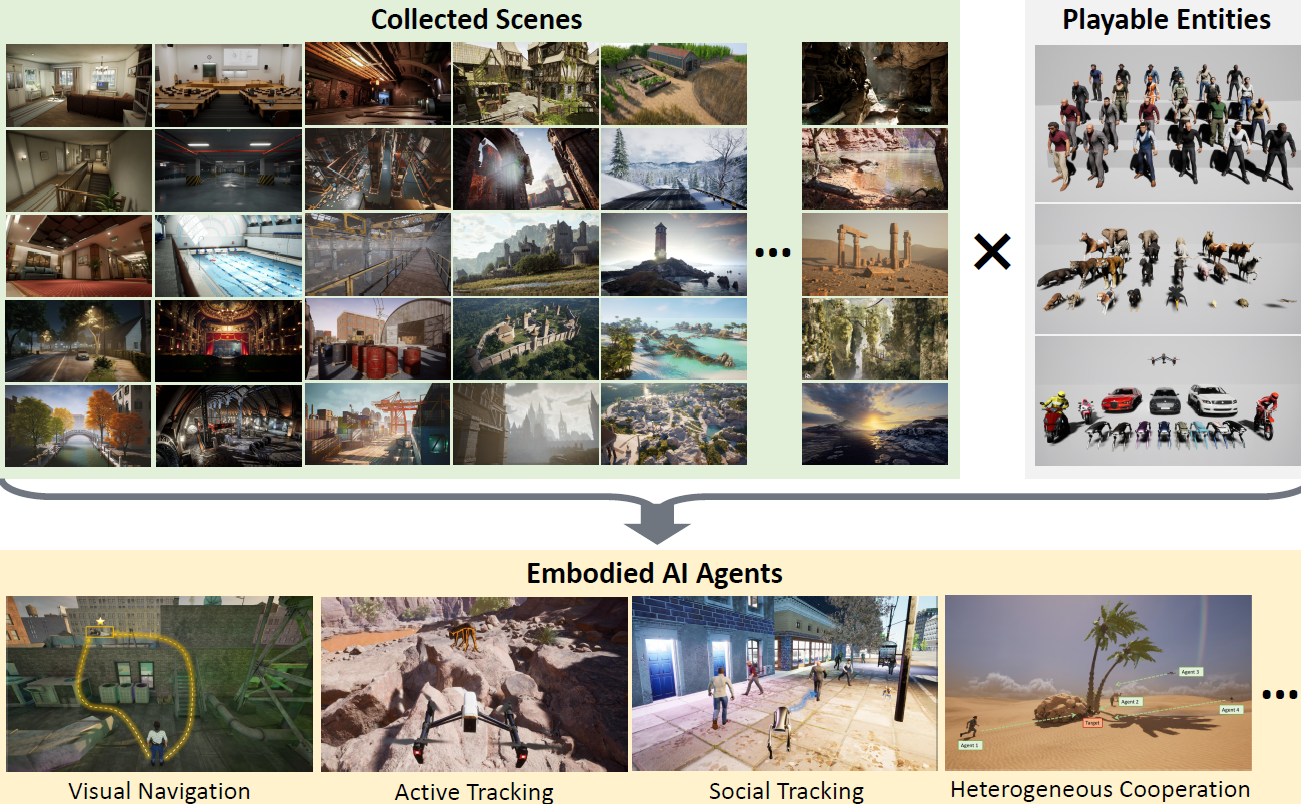The development of virtual environment technologies has revolutionized AI research. Traditional simulators often focus on specific scenarios like indoor navigation or autonomous driving, which limits the ability of AI agents to adapt and generalize to diverse real-world situations. Key metrics such as success rates and average episode lengths indicate significant performance gaps in such traditional simulators. Creating immersive environments that can accurately capture or mimic real-world complexities requires high-quality rendering and realistic physics.
Advanced game engines like Unreal Engine play a key role in immersive environments, offering tools that can enhance visual realism and enable detailed interactions between agents and their surroundings. By leveraging these technologies, scientists can create dynamic, lifelike simulations that serve as more effective training grounds for AI agents.

UnrealZoo enriches photo-realistic virtual worlds by combining diverse scenes and playable entities. It enables training generalizable embodied AI agents for tasks such as navigation, active tracking, and social interactions. Additionally, UnrealZoo facilitates the benchmarking of agents in realistic virtual worlds, helping to identify challenges in open-world deployments.
UnrealZoo: Bridging the Gap Between Simulations & Real-World Scenarios
The authors introduced UnrealZoo, which utilizes Unreal Engine and UnrealCV to provide different environments featuring dynamic elements, complex designs, and interactive entities. The goal was to address the limitations of traditional simulators by providing a collection of 100 high-quality, photo-realistic scenes designed by artists to replicate realistic lighting, textures, and dynamics. These scenes closely resemble real-world settings, enabling AI agents to train and operate in environments that mirror real-world complexities.
The UnrealZoo platform integrates UnrealCV+, an enhanced suite of Python APIs, which supports tasks such as data collection, environment augmentation, and distributed training and testing. The optimized rendering and communication efficiency of UnrealCV+ enables seamless interactions in large-scale, multi-agent scenarios.
To achieve this, the researchers applied a systematic methodology, conducting experiments with various AI agents across diverse environments. They then evaluated the performance of these agents by benchmarking them in tasks such as visual navigation and active tracking, leveraging reinforcement learning (RL) algorithms.
UnrealZoo: Enriching Photorealistic Virtual Worlds for Embodied AI
Experimental Findings and Key Insights
The outcomes indicated that training in diverse environments significantly improved the generalization abilities of AI agents, enabling them to perform effectively across various scenarios. The authors emphasized the critical role of control frequency in dynamic scenarios, highlighting the importance of low-latency communication to maintain performance stability.
The RL agents trained in varied environments showed enhanced performance in tasks such as visual navigation and active tracking. For instance, in experiments across unstructured terrains, agents trained in diverse environments achieved up to 92% success rates compared to those trained in limited environments. These results highlight the importance of diverse training data to improve the robustness and adaptability of AI agents. This approach can lead to the development of more resilient and adaptable AI agents capable of functioning effectively in various applications, from urban planning and disaster response to healthcare and social robotics.
The study also highlighted key challenges faced by RL-based and vision-language model (VLM)-based agents in open-world scenarios. These included difficulties navigating unstructured terrains, adapting to dynamic environmental changes, and requiring advanced spatial reasoning. Notably, VLM-based agents struggled with real-time adaptability due to response delays and underperforming in tasks requiring immediate decision-making. The researchers emphasized that addressing these challenges is crucial for successfully deploying embodied AI agents in real-world applications.
Practical Applications
The newly developed platform provides a robust framework for advancing embodied AI research. It can be utilized for various applications, including training agents for navigation, object tracking, and social interactions in complex environments. By providing a diverse collection of environments, the platform enables scientists to address new challenges and develop innovative approaches in AI. For example, UnrealZoo has been used to benchmark agents in dynamic social environments, evaluating their ability to interact with crowds and handle active distractions. The insights gained from these experiments can guide the design of future AI systems, especially those intended for real-world deployment. Additionally, benchmarking agents in realistic virtual settings can help identify limitations and refine algorithms, ultimately improving the performance and reliability of AI systems.
Conclusion and Future Directions
In summary, UnrealZoo represents a significant step forward in embodied AI, providing a robust framework for training and evaluating intelligent systems in complex virtual environments. The authors emphasized the importance of diverse environments in enhancing agent performance and adaptability. As technology evolves, their platform has the potential to significantly advance AI research, thereby supporting the development of more capable and sophisticated embodied agents.
Future work should expand the platform’s range of environments and entities, refine APIs and tools for better usability, and incorporate advanced machine learning (ML) techniques to create agents capable of navigating and interacting in complex scenarios. Addressing limitations such as low cross-embodiment transferability and inadequate handling of intricate obstacles will be critical in advancing the platform's utility. Overall, this study will enhance embodied AI research and contribute to a broader understanding of how agents can effectively function in dynamic, real-world situations.

 *Important notice: arXiv publishes preliminary scientific reports that are not peer-reviewed and, therefore, should not be regarded as definitive, used to guide development decisions, or treated as established information in the field of artificial intelligence research.
*Important notice: arXiv publishes preliminary scientific reports that are not peer-reviewed and, therefore, should not be regarded as definitive, used to guide development decisions, or treated as established information in the field of artificial intelligence research.
Source:
Journal reference:
- Preliminary scientific report.
Zhong, F., & et al. UnrealZoo: Enriching Photo-realistic Virtual Worlds for Embodied AI. arXiv, 2024, 2412, 20977. DOI: 10.48550/arXiv.2412.20977, https://arxiv.org/abs/2412.20977